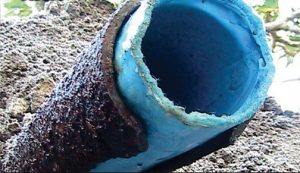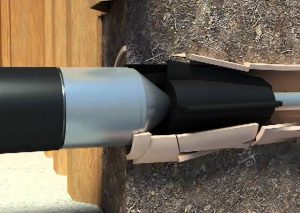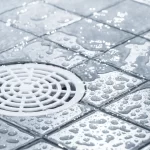Whether it is a home or a business, broken or failing underground pipes can be a real problem. When a property owner realizes that an underground sewer or water line needs to be replaced or repaired, it can cause a lot of stress. They think about how extensive the work is going to be, and they wonder about how much of the ground is going to need to be disturbed in the process.
As a property owner in Toronto, what you may not realize is that many underground pipe repairs can be done without having to dig up the pipe. With a plumber that specialises in trenchless drain repair, the work can be done with a limited impact on the ground around the area of the repair. In this post, we are going to look at two of the most popular methods for trenchless drain repair in Toronto.
Cured-in-place pipe lining
 Cured-in-place pipe lining is one of the go to methods for underground drain repair. This method is preferred by many professionals because it is the least invasive when it comes to disturbing the ground on the property.
Cured-in-place pipe lining is one of the go to methods for underground drain repair. This method is preferred by many professionals because it is the least invasive when it comes to disturbing the ground on the property.
With CIPP, underground drains can be repaired without having to unearth the pipe that needs to be worked on, and it is ideal for repairs that involve things like punctures and cracks. This type of trenchless pipe repair can work in a wide range of situations, and it can be applied to pipes made from a wide range of materials. It can also be used to repair pipes that carry sewage, water, gas and chemicals.
How it works
This type of drain repair works by applying a resin-soaked liner to the drainpipe. The epoxy will cure in place and form a bond to the existing pipe.
The process usually starts with an inspection of the damaged pipe. The plumber will run a camera down the line to survey any damage and to look for any obstructions that may get in the way of the pipe lining process.
Once the pipe is cleared, the plumber will then begin to prepare the materials for the lining process. The process starts by drawing a felt tube with a PVC liner into the damaged pipe. The resin-soaked liners are also pulled down the pipe with the assembly, and they are guided into place using camera equipment.
When the liner has reached its desired position, air pressure is used to invert the liner and hold it in place against the section of pipe that needs to be repaired. In general, about 10-12 PSI of air pressure will be applied to the liner to hold in place against the section of damaged pipe. It usually takes about 3-4 hours of pressure for the epoxy to properly cure.
After the pipe has cured, the air pressure is released, and the inflation bladder is removed. A final inspection of the pipe and liner will then be performed.
The benefits of CIPP
The use of cured-in-place pipe lining has many benefits. The first and most obvious is that it allows the plumber to repair an underground pipe without having to dig it up. That said, there might be some need for a small trench to be dug. If the line can be accessed through an upstream manhole, most of the repair work can be done from there. If not, the plumber may need to dig a small trench to gain access to a section of the pipe.
Another advantage to CIPP is that it will usually cost less than conventional methods. With little to no excavation, it reduces the amount of time that it will take to perform the repair, so this can cut the labour costs that go into the job. Additionally, you do not have to worry about fixing any expensive landscaping.
The versatility is another advantage to CIPP. As I mentioned before, it can be applied to pipes made from a wide range of materials, and it can work to rehabilitate pipes that are used for a wide range of purposes. In addition to that, a skilled technician can use this method to repair long sections of damaged drainpipe or you could even do point repairs and repairs to smaller sections of the drainpipe. An expert plumber will be able to give you an idea of how to proceed at this point.
As a final point, cured-in-place pipe lining is incredibly durable. The liners usually come with an extensive warranty, and when all goes well, the property owner will not even need to start thinking about repairs to the lined pipe for at least fifty years.
Pipe Bursting
 Pipe bursting, also known as “torpedoing” is another method for trenchless pipe repair. Instead of repairing the existing pipe, this method is used to replace the pipe in the ground. Just like CIPP, it can be used on pipes that are made from various materials, and it can also work for pipes that carry everything from water and sewage to gas and chemicals.
Pipe bursting, also known as “torpedoing” is another method for trenchless pipe repair. Instead of repairing the existing pipe, this method is used to replace the pipe in the ground. Just like CIPP, it can be used on pipes that are made from various materials, and it can also work for pipes that carry everything from water and sewage to gas and chemicals.
This method is not only used to replace damaged pipes in the ground, but it is also a common practice for when pipes need to be upsized. If the flow and capacity of an underground pipe need to be increased, pipe bursting can be used to replace the smaller pipe with something that has a larger diameter.
While pipe bursting can avoid much of the need for excavation, the process will usually require some digging. At each end of the pipe that is going to be replaced, the plumber will need to dig pits for insertion and receiving.
How it works?
At the beginning of the process, pits will be dug at each end of the pipe that needs to be replaced. At the one end, you have the insertion pit, and at the other, you have the receiving pit.
At the insertion pit, the new pipe will be fitted with a bursting head. This is a head that is shaped almost like as bullet, but it may have fins that help it to break the old pipe as it moves through the line. The tip of the bursting head will be narrow enough to fit in the existing pipe, and then it should widen to about 50-100 mm larger than the new pipe. The smaller lead end of the bursting head helps to guide the pipe through the path of the existing pipe, and the wider end with the fins bursts the old pipe as it moves through the line.
From the receiving end, the bursting head and the new pipe will be pulled through the host pipe using heavy interlocking links that form a chain. The chain is pulled through the host pipe using a winch. As the winch pulls the bursting head through the pipe, it fragments the old pipe and creates a cavity for the new pipe. The replacement pipe follows directly behind the bursting head, and this ensures that the new pipe follows the exact path of the pipe that is being replaced.
Benefits of pipe bursting
Pipe bursting is especially advantageous for situations where the pipe cannot be repair or for when the pipe needs to be upsized. It allows this type of work to be done without having to undergo extensive excavation, though it is not entirely trenchless.
This is especially beneficial for situations where pipe needs to be replaced under a roadway. Instead of having to damage the road and repair the surface, the pipe can be replaced with much less work. This not only reduces the cost by eliminating some of the excavation that may need to be done, but it also cuts down on the amount of labour that goes into the job, and it is generally quicker than replacing a drain or pipe using conventional methods.
This method is also very versatile. As I mentioned before, it can work on pipes made from a wide range of materials, and it can also be used to replace pipes that have various purposes. It can work on pipes of almost any size, and it can be used to replace lengths of drainpipe that run to well over 100 meters.
It is generally used for replacing pipes that are made from a brittle material that will easily burst as the head moves down the line. However, there are some types of pipe that may not be suitable for pipe bursting. With pipes that are made from materials like plastic or steel, pipe splitting is used.
Pipe splitting is a trenchless pipe replacement method that is similar to pipe bursting. Since materials like plastic and steel may not fragment in the same way that clay or concrete would, the pipe has to be cut. Instead of using a bursting head, a similar process would be performed, but in this case, the head would have cutting blade to split the pipe as it moves down the line. An expansion shell then follows the cutting head, and this separates the sections of pipe and creates the cavity for the replacement line.
Which Toronto trenchless drain repair method is better?
Both of these methods for trenchless pipe repair are good, and they each have their place. With these technologies, the process of repairing and replacing underground pipes has been made safer, easier and they reduce the labour that comes with this type of work. Another great advantage to these methods is that they both allow the work to be done with a minimal disruption to the service and the ground around the work area.
When it comes to which method is better for a given situation, the answer depends on a variety of factors. In some cases cured-in-place pipe lining will be the right answer, in others, you will need to go with pipe bursting.
CIPP is probably the best options for when the existing pipe is still usable. If it is a simple crack, a puncture or something like a tree root that has penetrated the drain line, this can be a simple, cost effective method for repairing the damage. However, there are situations where the pipe has been damaged to such an extent that drain lining is not going to be able to repair the damage. In those cases, you will need to consider your options for pipe replacement.
Pipe bursting is great for when pipes need to be upsized, but it is also the ideal solution for a pipe has sustained significant damage, and needs to be replaced. It is quicker and less disruptive than the conventional methods, and it makes for a replacement that is more affordable. If the existing pipe is made from a material that is not suitable for pipe bursting, you could also consider pipe splitting. It comes with all of the advantages of pipe bursting, but it is just a different method that is more suitable for different materials.
In some cases, trenchless drain repair might not be possible. The average residential sewer drain should not be too long for a CIPP repair, but once the liner reaches a certain length, special equipment and process will be needed. If your drain line or repair requires a liner that is too long, it may not be practical to employ the use of cured-in-place pipe lining.
The viability of pipe bursting and pipe splitting can also be subject to the soil conditions on the property. The process or bursting a pipe creates a percussive force that can affect the ground around the work area. For conditions where the soil is loose, sandy or rocky, this could cause problems. For most pipe bursting operations, a site survey will need to be performed to determine whether the ground conditions are suitable for such an operation.
Getting an underground pipe repaired or replaced can be much simpler than you may have expected. Toronto trenchless drain repair solutions like cured-in-place pipe lining and pipe bursting can cut the cost and limit the amount of damage that has to be done to the surrounding property. Both options offer repairs that are extremely durable, and they can both rehabilitate the operation of your sewer with only a limited disruption of service.






